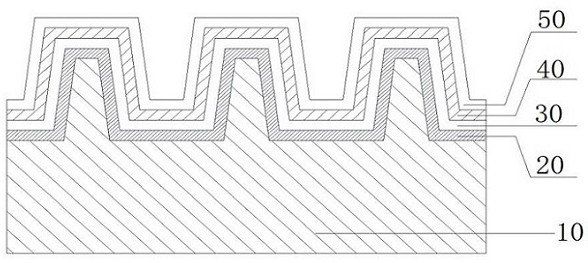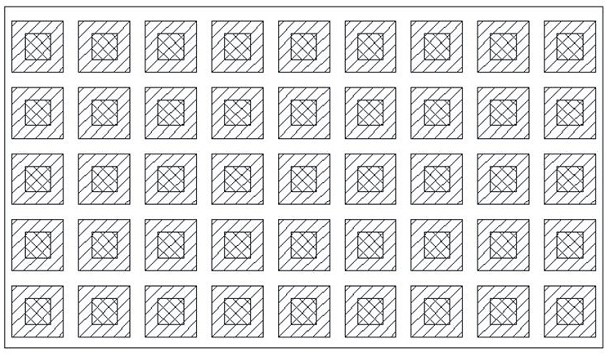Hydrogen absorption device for hydrogen sensitive hybrid integrated circuit and preparation method thereof
A hybrid integrated circuit, sensitive technology, applied in the direction of electric solid-state devices, circuits, electrical components, etc., can solve the problems of poor robustness, high cost, low hydrogen absorption efficiency/rate, etc.
- Summary
- Abstract
- Description
- Claims
- Application Information
AI Technical Summary
Problems solved by technology
Method used
Image
Examples
Embodiment 1
[0131]With a 0.3mm thick alumina ceramic sheet as a carrier, a cuboid micro-cone with a height of 0.8mm×0.8mm×0.1mm (length×width×height) and an inclination angle of 80 degrees is formed on the surface to enhance the specific surface, and the entire surface passes through Chemical roughening further enhances the specific surface, such as Figure 3a shown. Then prepare the surface film layer by magnetron sputtering process, cover the surface of the carrier with 20 μm 4N (purity 99.99%) metal titanium as the hydrogen absorption layer, and cover the hydrogen absorption layer with 1 μm thick cobalt as the selective hydrogen permeation layer. Cover the selective hydrogen permeation layer with palladium with a thickness of 10nm as a protective layer, and finally, spray a layer of PDMS with a thickness of 10 μm on the surface as an anti-particle shedding layer, such as Figure 3b shown.
[0132] in Figure 3b It shows the schematic structure of the surface film layer prepared on t...
Embodiment 2
[0134] A 10mm×5mm×1mm (length×width×height) zero-order sponge titanium is used as a carrier and a hydrogen absorbing layer, and a layer of 500nm thick metal palladium is electroplated on its surface and hole wall as a selective hydrogen permeating layer and a protective layer ,Such as Figure 4a As shown; then the surface is sprayed with a layer of 15 μm polystyrene (Polystyrene: MW=280K) polymer film as an anti-particle shedding layer. In this embodiment, the same metal palladium is used for the selective hydrogen permeable layer and the protective layer. Do.
[0135] in, Figure 4b Indicates that the zero-grade sponge titanium includes: 500nm-thick metal palladium doubles as a selective hydrogen permeation layer and a protective layer, and a 15μm-thick polystyrene (Polystyrene: MW=280K) polymer film anti-particle shedding layer.
Embodiment 3
[0137] 3N5 (purity 99.95%) titanium belt (thickness 0.2mm) is used as the carrier and hydrogen absorbing layer, and the surface is enhanced by surface enhancement processing to form micro-cone grooves with a height of about 50 microns to enhance the specific surface, such as Figure 5a As shown; Cobalt with a thickness of 0.5 μm is used as a selective hydrogen permeation layer and palladium with a thickness of 10 nm is used as a protective layer, and no anti-particle shedding layer is used.
[0138] Figure 5b It shows the schematic structure of the surface film layer prepared on the basis of the titanium tape carrier, including a cobalt selective hydrogen permeation layer with a thickness of 0.5 μm and a palladium protective layer with a thickness of 10 nm.
[0139] Wherein, numeral 12 represents a micro-cone groove structure.
PUM
| Property | Measurement | Unit |
|---|---|---|
| thickness | aaaaa | aaaaa |
| thickness | aaaaa | aaaaa |
| thickness | aaaaa | aaaaa |
Abstract
Description
Claims
Application Information
 Login to View More
Login to View More - R&D
- Intellectual Property
- Life Sciences
- Materials
- Tech Scout
- Unparalleled Data Quality
- Higher Quality Content
- 60% Fewer Hallucinations
Browse by: Latest US Patents, China's latest patents, Technical Efficacy Thesaurus, Application Domain, Technology Topic, Popular Technical Reports.
© 2025 PatSnap. All rights reserved.Legal|Privacy policy|Modern Slavery Act Transparency Statement|Sitemap|About US| Contact US: help@patsnap.com



